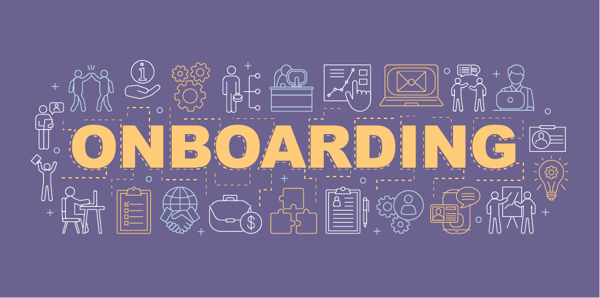
The Vital Role of Corporate Culture in Onboarding
It takes an enormous amount of planning, effort, and time to recruit and hire employees who will become great additions to an organization. With so many resources invested in making the best staffing choices, it should be equally important to have an onboarding process to bring new hires into the fold and make them want to stay.
Surprisingly, many businesses don’t make that connection.
According to Gallop’s 2017 “State of the American Workplace” report, only 12% of employees strongly agree that their organization does a great job of onboarding new staff. That means most employers are wasting a critical team-building opportunity.
Job candidates learn a lot about a company during the hiring process, but they don’t know what it feels like to be part of an organization until the paperwork has been signed. They form their first impression as team members as soon as they agree to take a job.
In the period that follows, employers should deploy a process to assure recruits that they not only made a good decision by accepting the job—they’ve found a new home.
Even companies that stress their strong culture and other attributes in job postings and during the interview process often drop the ball once recruits walk through the door. Companies that don’t prioritize onboarding miss their best chance to kindle long-lasting relationships with employees.
In the words of Will Rogers, “You never get a second chance to form a first impression.”
Your Business Can’t Afford to Downplay Onboarding
A term that makes business leaders cringe is “new hire turnover,” and their unease is well-grounded. According to Harvard Business Review, the statistics are unsettling:
- Nearly 33% of new hires look for a new position in their first six months on a job.
- 23% of employees leave before their first work anniversary.
In addition to the upheaval that rapid turnover causes within existing ranks, a retention problem is extraordinarily expensive. Glassdoor reports that the average U.S. employer spends about $4,000 to hire each new worker.
As concerned as they are about the numbers, many employers don’t understand the role that effective onboarding has on retention. But the impact is significant. A study by Brandon Hall Group shows that organizations with an effective onboarding process improve new hire retention by 82%.
With all of that in mind, creating a process that instills a sense of belonging in recruits is a sound business practice. As Peter Cappelli from the University of Pennsylvania’s Wharton School notes:
“Hiring employees is the biggest investment most organizations make. Understanding how to make sure that investment sticks is what onboarding is about.”
Onboarding vs. Orientation: What’s the Difference?
Many employers believe they have an onboarding process in place when in fact, they’ve implemented an orientation process. Orientation is part of an onboarding program—but by itself, it doesn’t do much to form that all-important first impression that has so much influence on new employees.
Here’s the difference:
- Orientation is the process of introducing new staff to their jobs, coworkers, and responsibilities. It’s a one-time event where one or more new employees are given forms to complete, a company handbook, and a chance to ask questions.
- Onboarding is a strategic business process to ensure each new hire is successfully immersed in company culture and operations. Onboarding focuses on the individual and provides perspective about how they fit into the big picture.
Orientation helps an employee understand basic operating procedures. Onboarding makes new hires feel like vital members of the team and initiates them into the organizational culture.
It’s a critical distinction in that corporate culture is the engine that drives overall success for the company and the people who work there.
How Onboarding Strengthens Company Culture
Most companies specifically look to hire people who will fit with their culture. But just because recruits have the potential to thrive in an organization doesn’t mean they’ll automatically know what to do to make that happen. That’s why onboarding is invaluable.
Terrie Nolinske of the National Business Research Institute observes:
“Onboarding has become a strategic approach that gives those organizations that use it a competitive advantage. Think about it. New hires lack knowledge about the culture and politics of the organization, the challenges they will face, and what they will need to do to be successful. A comprehensive plan to address those areas is a win-win for everyone.”
An effective onboarding program will involve new employees in various exercises and discussions that explain the way team members work and interact to reach organizational goals. These defined behaviors are what bring a company’s values to life and form the culture.
As author and CultureWise CEO David Friedman writes in Culture by Design,
“The onboarding or integration program should support and deepen the company culture by managing early impressions and setting people up for success.”
3 Steps to Integrate Culture into the Onboarding process
After candidates have been identified as cultural fits and hired, employers should tailor that fit through the onboarding or assimilation process. Friedman uses the analogy of handing a new employee a pair of prescription eyeglasses to get them to see things clearly.
“You have the ability to write the prescription for the glasses a new person puts on. They’re going to see, hear, and experience a variety of things, and you can influence the interpretation they apply to those events. Done properly, you have an opportunity to shape their perceptions.”
The length of time for the process may vary depending on the employee’s position, but the method should remain the same for everyone.
Friedman recommends three steps to successfully onboard a new hire.
- Introduce the Culture
As explained in Culture by Design, employees come in as “blank slates,” and everything they experience is creating an imprint. Friedman stresses the importance of orchestrating a new team member’s early experiences so they can perceive how well they fit in.
Even great cultural fits still need to be taught the ins and outs of a company’s specific culture. Management shouldn’t assume that they’ll figure it out on their own.
The ideal person to start this process is the CEO or the highest-ranking person available. It’s an opportunity for them to demonstrate their passion for the culture. Moreover, the boss’s participation signifies the importance that culture plays in the company.
After the company leader gets the ball rolling, the discussion can and should broaden to a much more in-depth exercise that involves management and other employees. It could include an eLearning component, video training, or other helpful tools to illustrate the culture thoroughly.
- Explain Context
The second thing to teach new employees is context—or how they fit into the macro-view of what the company does. As Friedman notes,
“If you simply put them in the corner and tell them to do their job, but they don’t understand how it connects with the big picture, not only will it be less satisfying for the employee, you’re limiting the extent to which they can make a meaningful contribution.”
Like the introduction phase, this part of the process can start small and doesn’t have to be complex. It can be as simple as a review of the organizational chart that describes each department and its role. Or it might include going over a linear diagram that shows the steps in the value chain and explaining how the recruit’s job connects to others in the organization.
This step could be expanded over time by having recent hires meet people in each department or even spending time in those departments to observe what they do.
The better new employees understand their roles; the more significant their contribution will be. People want to work in a place where they have a sense of purpose and feel like they’re making a difference on the team.
The potential to have that kind of connection is one of the main reasons a recruit accepts a job offer and will be one of the things they’ll monitor after they start. Explaining context helps build employee engagement.
- Provide Support
The third element that every integration program should include is seemingly obvious but so often overlooked: logistics. It’s essential to take the time to explain the day-to-day, mundane things that help people function effectively. People shouldn’t have to wonder how to get IT support, order supplies, or find documents.
Friedman recommends an easy way to address this topic. Go to the last five people that were hired and ask them to name three things they wish they’d been told on their first day. Then compile a list of those topics and make sure someone personally addresses each one with new employees.
The faster a new person starts to feel relaxed, comfortable, and confident, the sooner they’ll be productive. When they’re given sufficient support, recruits begin to build loyalty for an employer that cares enough to proactively address questions they may have and provide what they need.
Is Your Culture Making A Good Impression?
Before incorporating an onboarding process that highlights company culture, it’s a good idea to evaluate that culture and look for ways to improve it. Even good organizational cultures can become better—and the stronger the culture, the more employees will excel and want to stay.
In addition to the chapter devoted to integrating new hires, Culture by Design provides an eight-step framework to create and maintain an exceptional culture. A free two-chapter download filled with practical advice for business leaders is currently available.
After Friedman wrote Culture by Design, he created the CultureWise program using all the components described in the book. CultureWise is a “turnkey operating system for culture” that provides a simple way for leaders to define, communicate, teach, and engage employees in their company culture.
Hundreds of business leaders have successfully improved their organizational culture by following the process outlined in the book or by taking advantage of the CultureWise suite of tools and a powerful app.
A strong culture is a company’s most powerful asset to attract top talent. And devising an onboarding method that demonstrates that culture is the best way to build long-term retention and a high performing team.

